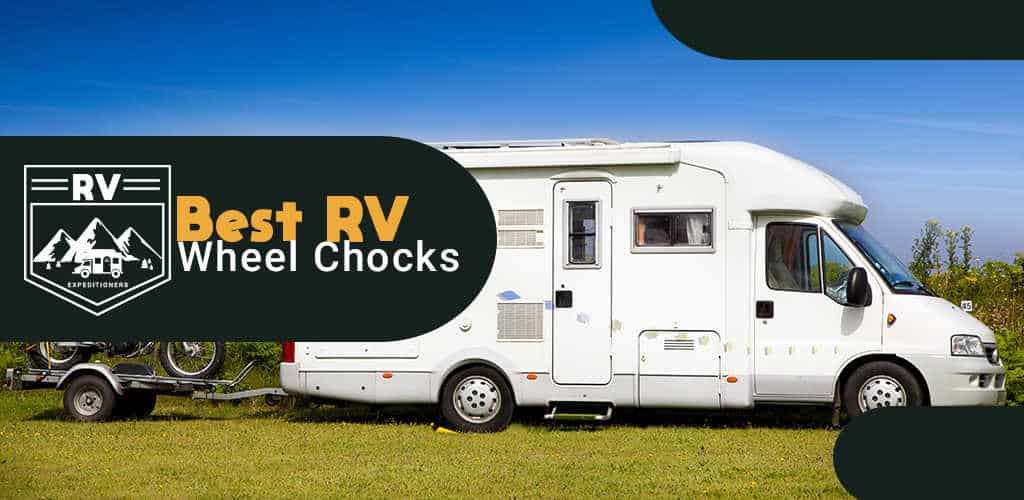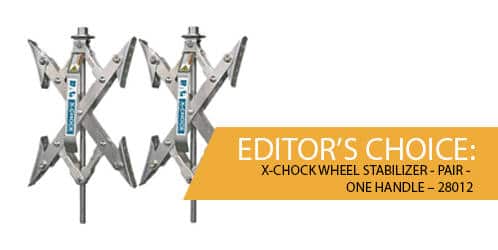For many RVers, the best way to travel is with a trailer. While motorhomes are great for many reasons, trailers give you a little more flexibility when it comes to transportation and getting around.
That being said, whenever you park your trailer (either at a campsite or home), you need to be sure that it’s stabilized correctly.
Today we’re going to be looking at the best RV wheel chocks, which can keep your trailer from rolling away.
COMPARISON CHART
| IMAGE | PRODUCT | |
|---|---|---|
 | 1. X-Chock Wheel Stabilizer - Pair - One Handle – 28012
| LEARN MORE ► |
2. Camco 44414 Wheel Chock
| LEARN MORE ► | |
3. MaxxHaul 70472 Solid Rubber Wheel Chock
| LEARN MORE ► | |
4. Fasmov Solid Rubber Heavy Duty Wheel Chock -2 Pack
| LEARN MORE ► | |
5. BAL 28005 Deluxe Tire Chock
| LEARN MORE ► |
OUR TOP 5 PICKS
#1 X-Chock Wheel Stabilizer - Pair - One Handle

Specifications
Item Weight | 11.4 pounds |
Product Dimensions | 16 x 7.5 x 4.5 inches |
Features
Typically speaking, when picking out a pair of chocks for your trailer, most of them resemble a giant wedge. Considering that a chock’s only purpose is to prevent the trailer from moving, a wedge is a simple and effective solution.
However, if you want something a bit more stable and reliable, the X-Chock Stabilizer from BAL R.V. Products Group is by far the better choice. Let’s see how it compares to the other options on this list.
Dual-Axle Stabilization
What makes the X-Chock so much better than the competition is that it stays locked in between the tires, rather than underneath. One of the most significant problems with standard chocks is that they may not maintain sufficient friction to keep the wheels in place.
With this product, however, you never have to worry about your trailer getting free. Although I never suggest parking on an incline, this chock is so rugged that you could almost get away with parking at an angle.
Adjustable Design
Because this chock sits between the wheels, you may think that it won’t work on all trailers. However, it can collapse to just over one inch and expand up to 10 inches. Regardless of the size of your RV, this product will work wonders.
- WHAT WE DON’T LIKE
- PROS/CONS OVERVIEW
Although there is nothing wrong with standard wedge chocks, I always find myself getting paranoid with them, particularly when the weather is wet. There’s a nagging feeling in my mind that moving around in the trailer will somehow knock them loose.
With the X-Chock, that worry goes out the window. Once it’s in place, I can move around freely without being paranoid that the wheels will slip. I also like the adjustability and rust-resistant metal of this design.
Video
#2 Camco 44414 Wheel Chock
Specifications
Item Weight | 1.45 pounds |
Product Dimensions | 8.4 x 6 x 5.1 inches |
Features
Typically speaking, RV wheel chocks are like this model from Camco. The design is simple yet effective. By placing high-inclined wedges against the trailer wheels, you can prevent shifting and motion easily.
Rugged Texture
When comparing different chocks, you’ll want to make sure to check that the surface is ribbed or textured. The reason why this is so important is so that the tires don’t slip on it.
If you’re placing chocks in wet weather, you’ll understand why having such a thick tread is necessary. Fortunately, these products from Camco are perfectly suited for this task.
UV-Protected Plastic
For the most part, I don’t usually like using plastic, especially when it will sit outside for days, weeks, or months on end. However, thankfully, these chocks come with a UV-protective layer so that they won’t become brittle and useless after a season of holding your trailer in place.
- WHAT WE DON’T LIKE
- PROS/CONS OVERVIEW
If you want a cheap set of chocks that will hold your trailer still, these products from Camco are a perfect choice. I like that they have rugged treads on the surface and that the plastic is so thick.
Video
#3 MaxxHaul 70472 Solid Rubber Wheel Chock
Specifications
Item Weight | 8 pounds |
Product Dimensions | 8 x 4 x 6 inches |
Features
When you’re looking at wedge-shaped RV wheel chocks, the choice is typically between plastic or rubber. I prefer the latter, which is what makes this set of chocks from MaxxHaul so desirable. Let’s see why they are perfect for your RV.
Weatherproof Rubber
One of the problems with plastic is that it can break relatively easy. Also, if the material isn’t treated to withstand UV rays, it will become brittle over time no matter what.
Fortunately, these chocks are made of heavy-duty rubber, meaning that they will last for decades. Not only that, but rubber has better traction, and it can take more abuse, so you don’t have to park on a flat surface to use these.
Built-In Handle
No matter how well you stick the chock underneath the wheel, the trailer will shift somewhat. Unfortunately, that can make it challenging to pull the chock out when it’s time to move.
Thankfully, these chocks come with a rugged rubber handle on the back, so the removal process is easier. Also, feel free to attach some rope to make it even more convenient.
- WHAT WE DON’T LIKE
- PROS/CONS OVERVIEW
When comparing rubber to plastic, I will take rubber every time. I like the traction that this material provides, as well as the level of abuse it can take. For the most part, your RV can roll up on these chocks without breaking them.
#4 Fasmov Solid Rubber Heavy Duty Wheel Chock -2 Pack
Specifications
Item Weight | 8.18 pounds |
Product Dimensions | 10.87 x 6.89 x 4.41 inches |
Features
Introducing the Fasmov Solid Rubber Heavy Duty Wheel Chock! This wheel chock is perfect for ensuring safety whether you are using a small vehicle or a large car, SUV, truck, or tractor. You can also use it with ramps or other lifting devices.
- WHAT WE LIKE
- WHAT WE DON’T LIKE
Pros
Cons
#5 BAL 28005 Deluxe Tire Chock
Specifications
Item Weight | 7.2 pounds |
Product Dimensions | 13.2 x 5 x 3.8 inches |
Features
We started this list with a scissor-type RV wheel chock, so it makes sense to end with one as well. Not only that but this particular product is made by the same company as the X-Chock. Let’s see how the 28005 model holds up.
Scissor-Style Chock
Don’t get me wrong - wedges are perfectly fine in most conditions. I like the simplicity of a wedge, and most RVers will appreciate how well they hold up over time.
That being said, I love the stability and rigidity that comes with a scissor-style chock. I never have to worry about slipping and sliding when I know that this piece of equipment is locking both wheels in place.
Rust-Resistant Metal
Chances are that this product will stay outside for most of its life. Fortunately, even though it’s made of metal, you don’t have to worry about it rusting and breaking down. You can use this chock for many seasons without any problems.
- WHAT WE DON’T LIKE
- PROS/CONS OVERVIEW
Overall, the stability, reliability, and design of this chock make it one of my favorites. Although it’s not as simple to use as the X-Chock, it’s better than most of the wedge-shaped options out there.
BUYER'S GUIDE
Are RV wheel chocks necessary?
Technically speaking, you do need to put chocks on your tires every time you park your RV trailer. If your tow vehicle is still attached, these products are not as vital, but I highly recommend placing them no matter what.
If you don’t use chocks, the trailer will shift and move, particularly when walking around inside. In worst-case scenarios, the trailer could roll away, causing irreparable damage to it and your tires.
How many wheel chocks for RV?
Realistically, you will need at least four chocks for your trailer. However, if you use a product like the X-Chock (which stabilizes two wheels simultaneously), you only need two.
The reason for having extra chocks is so that you can place them in front and behind the wheels. This way, you don’t have to worry about trailer movement in either direction.
Also, don’t assume that blocking one side will be sufficient. Safety is always a priority, and chocking both sides will ensure that your trailer stays put the whole time.
How to use RV wheel chocks?
If you buy standard wedge-shaped versions, you will need to place one on each side of your trailer wheels. If the trailer has two tires next to each other, place the chock in front of the first wheel and behind the second.
Products like the X-Chock fit between the wheels. Obviously, if your trailer is small enough to only have one tire per side (i.e., a travel trailer), then this product won’t work.
How to make RV wheel chocks?
You might think that placing a block of wood will be sufficient to keep your trailer in place. However, it’s far too easy for the wood to shift or get pushed out of the way, making it an unsafe choice.
Chocks are ideal because they prevent the wheel from moving at all. That being said, you need to make sure that it has sufficient traction. If not, then you’ll have to place textured rubber on the surface so that the wheel won’t slip on it.
Where should wheel chocks be placed?
A chock should be placed in front and behind the wheels to ensure that there is no movement in either direction. Again, be sure to put them on both sides for better safety and reliability.CONCLUSION
While I like standard wedge chocks for their ease and simplicity, I can’t recommend the X-Chock enough. When it comes to the best RV wheel chocks, the X-Chock is by far the most reliable and most rugged of the bunch.
I appreciate how well it holds the tires in place, as well as the fact that it can withstand the weather. Overall, you can feel safe and sound when the X-Chock is in place.

















Thanks for sharing, it is a great article and I also like your opinions about pros and cons of each product. This is very useful for me so please update more of posts like this.
I think MaxxHaul 70472 Solid Rubber Wheel Chock is also good wheel clocks. I am using them and I am satisfied with almost its features such as a built-in handle or keep the camper secure in place. It is a good choice for RVers.
I purchased Camco chocks to use on vehicles while working on them. I placed the chocks behind my tires, had my car in neutral, and released the parking brake. The car rolled slightly up on the chocks and the chocks did not slide on my driveway. I gave the car a slight push and bump to make sure any force wouldn’t drive the car over the chocks or see if the chocks would move. They have worked great and have not moved.
Worth article! I just want to say thank you for sharing.